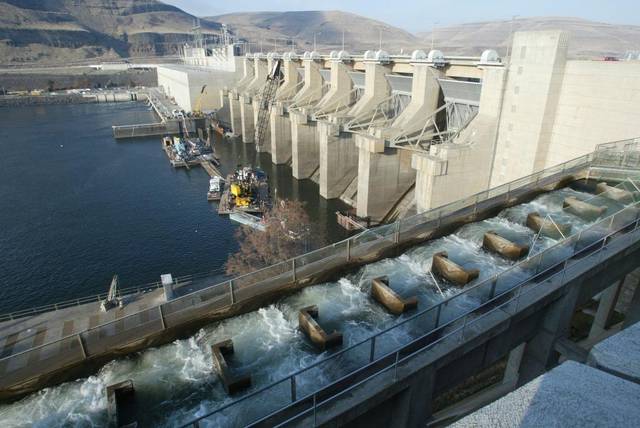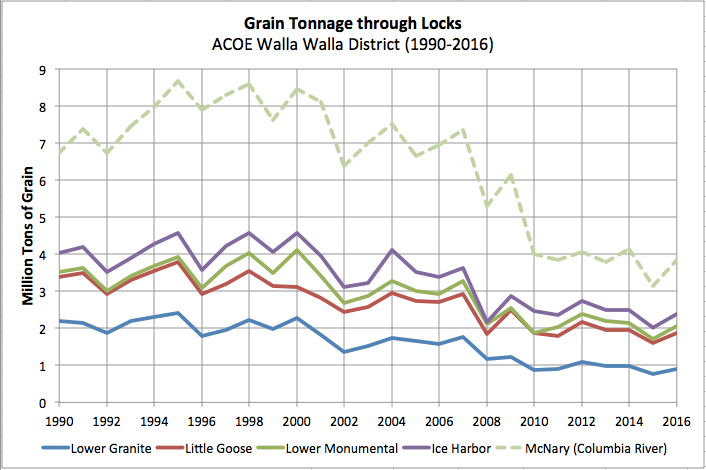forum
library
tutorial
contact

A Changing Electrical Grid May Make Snake River
Dams Expendable -- and Help Save Salmon
by Rocky Barker
Idaho Statesman, August 6, 2017
|
the film forum library tutorial contact |

|
A Changing Electrical Grid May Make Snake River
by Rocky Barker
|
Editor's note: The Northwest has yet to figure out a sustainable plan to save imperiled Columbia salmon.
This is part two of a series exploring whether salmon can ultimately survive.
 PASCO, WASH. -- The fate of the Northwest salmon may be decided by the way you use your heater and your air conditioner.
PASCO, WASH. -- The fate of the Northwest salmon may be decided by the way you use your heater and your air conditioner.
In the near future, the U.S. electric grid will be able to digitally manage the vast Northwest hydroelectric network in a way unimaginable just a few years ago. With consent from customers, it will be able to adjust the heaters and air conditioners of millions of homes and buildings, or tap into the batteries of electric cars or other smart appliances.
It's a revolutionary change for the Northwest economy, the energy market, the Columbia Basin dam system and the salmon that migrate through it.
The four dams of the Snake River in Washington are less valuable now due to a power surplus caused by wildly successful energy-efficiency programs, cheap natural gas, and rapidly growing wind and solar energy options.
The dams hinder the salmon that spawn in the best habitat in the Northwest -- in Central Idaho. And this stronghold has the highest, coolest mountain streams that may keep salmon surviving in a warmer, drier future.
Twenty years ago, arguments against breaching those dams centered around the loss of crucial power supplied to the region. But as the role of the dams in the Northwest hydrosystem changes, so does their role in the political and environmental ecosystem. As the four lower Snake dams become less relevant pieces of a larger, flexible network, they become more vulnerable.
Climate change has contributed to this transformation because public policy demands the low-carbon power like the dams produce.
The future of the Northwest's hydroelectric system will be to augment the ever-growing supply of intermittent low-carbon energy sources like wind and solar. It also will continue to play a crucial role as quick-response electricity at times of peak demand.
But the dams still have strong political and cultural pull. Wheat farmers in Idaho and eastern Washington still depend on shipping their grain and staying competitive in the Asian markets even though shipping on the Snake has dropped more than 70 percent since 1998.
Independent biologists say the $16 billion spent over the last two decades is not enough to offset the effects of the dams and climate change on wild salmon and steelhead. And some already argue that the savings from removing the four dams on the lower Snake River and spending less to mitigate the damage to salmon exceeds their benefit to the electric grid and economy.
If the four dams are less important to the Northwest electric grid, argues Ben Otto, a Boise lawyer and environmentalist who chairs the Northwest Energy Coalition, they are more critical than ever to the Idaho salmon that migrate down and up the Snake River.
"Removing these dams is very important to allowing salmon a chance to move freely between the habitat they need to live," Otto said.
DO WE NEED THE POWER?
The 1,000 megawatts the four dams produce annually -- enough to supply the city of Seattle, are mostly produced in the spring, when water is plentiful but electric demand and prices are low. The Bonneville Power Administration pays wind producers to turn off their generators at times of surplus power in the spring.
The greatest value these four run-of-the-river dams provide is "sustained peaking capacity," which means the ability to meet energy needs for four to eight hours when a cold spell or heat wave produces a big surge in electricity demand.
The region is forecast by 2021 to have a shortage, which makes the grid less reliable due to the planned closing of coal-fired power plants in Oregon, Washington and Montana. Removing the four lower Snake dams would make the system slightly less reliable , said John Fazio, an energy analyst with the Northwest Power Planning and Conservation Council.
But the council, an eight-member panel appointed by the governors of Oregon, Washington, Idaho and Montana to advise the BPA, says in its latest plan that 3,500 megawatts will be available as demand-response technology develops, enough to keep the system safe.
A series of digitally connected buildings, for instance, could have their thermostats raised or lowered by a half a degree or more to reduce the peak demand load when needed. The same technique can be used when the wind doesn't blow or clouds cover solar generators.
The Pacific Northwest National Laboratory's many scientists are helping develop new technologies, including storage batteries that can make the region's renewable energy meet the same need.
"The reality is we just aren't there yet where we can replace baseload hydroelectric power," said David Reeploeg, the council's vice president for federal programs.
But Otto and other green energy supporters say that could change within the next decade and they are confident the current system can be reliable without the four Snake dams.
 TIME FOR A DECISION
TIME FOR A DECISION
The Columbia River system once sustained 8 million to 16 million salmon returning annually. But 150 years of overfishing, habitat destruction, dam building and water pollution took its toll. By 1995, less than 800,000 returned and Columbia Basin salmon were listed under the Endangered Species Act, a law that forces the federal government to show its actions help, not harm, the fish.
Three federal judges since 1994 ordered the BPA, the Army Corps of Engineers and the Bureau of Reclamation to take increasingly stronger steps to reduce or offset the effects of the dams on salmon.
U.S. District Judge Michael Simon has now ordered the agencies to conduct a new environmental review and plan, with an immediate plan for operating the dams due by 2018 and a final decision on a long-term plan by 2021. Simon said that plan must include a review of keeping or breaching the four Snake dams, the latter being an option that many scientists argue is the best way to rescue those imperiled salmon. The four dams are Ice Harbor, built in 1961; Lower Monumental, built in 1969; Little Goose, built in 1970; and Lower Granite, built in 1975.
As the court cases have crept along, technology, politics and money have transformed the electrical grid that serves as the foundation of the Pacific Northwest's $820 billion economy. The transformation goes well beyond the growth of renewable energy sources and replacing coal with cheap natural gas.
"The industry is going through a fundamental change and nothing is standing still," said Shauna McReynolds, executive director of Pacific Northwest Utilities Conference Committee. "Environmental policies and other policies are driving the industry like they never have before."
Will Hart, executive director at Idaho Consumer-Owned Utilities Association, represents 130,000 Idahoans who get all or part of their electricity from the federal dams. He points to two reasons they remain a public good: the carbon they avoid and the historic returns of mostly hatchery salmon during the last decade.
"I see a future for those dams," he said.
He thinks the 30 percent of his customers' power bills that go to salmon costs have been worth the price. But Jim Waddell, a retired U.S. Army Corps of Engineers manager who led the last environmental review of the four dams, in 2002, said the costs for those dams far outweigh the benefits.
"For every dollar the taxpayers and the ratepayers invest in these four dams, they get back 15 cents," Waddell said.
WE'RE LOSING 85 CENTS FOR EVERY DOLLAR WE SPEND ON THESE DAMS.
 Elliott Mainzer is the administrator of the BPA, the agency that markets the power from 31 federal dams in the Columbia Basin. It was created in 1937 to sell the power generated by the Northwest's growing network of dams to public utilities -- from the Pacific inland to as far away as Montana, Wyoming and Nevada.
Elliott Mainzer is the administrator of the BPA, the agency that markets the power from 31 federal dams in the Columbia Basin. It was created in 1937 to sell the power generated by the Northwest's growing network of dams to public utilities -- from the Pacific inland to as far away as Montana, Wyoming and Nevada.
Mainzer has to determine whether there are savings on salmon-preservation programs and other measures that would balance the loss of the four dams' flexibility. But he's not ready to contemplate a Northwest without the dams.
"This is an evolutionary process," he said, "and there is a lot of runway ahead of us."
But there's no denying the technology that is creating new energy markets and new ways to balance the electric grid. Today, big dams such as Grand Coulee in Washington state, with its massive reservoir behind it, keep the amount of power in the grid stable by instantly producing power when it's needed.
But that is changing. In the future, the grid will be stabilized by "demand response management" -- turning millions of interconnected appliances and ACs on and off, and tapping batteries in electric cars and other sources.
The hydropower posse promotes the dams' importance
Will Hart, who represents 130 Idahoans who get their power from the federal dams in Oregon and Washington, explains how important they are to the municipal utilities and rural co-ops that buy their power from the Bonneville Power Administration.
This transformation presents major challenges for the BPA, which has extensive investments in existing energy infrastructure like dams and transmission lines that keep power flowing reliably to customers such as Weiser Mayor Diana Thomas.
Weiser, a city-owned utility that serves 2,800 residents, buys its power from BPA, which is required by law to sell power to public utilities and rural cooperatives at cost. That cost has historically been among the lowest in the nation.
The low electric costs helps the communities attract and keep industry, Thomas said, while keeping costs low for heating and cooling schools and the town's hospital. "That's huge to have that savings," Thomas said.
Bonneville's hydroelectricity is no longer automatically the cheapest available to its traditional customers. That's because the huge growth of wind, solar and other renewable energy sources, along with cheap natural gas prices, has cut BPA's opportunity to sell its surplus power to California and other utilities at a profit. BPA has historically used those profits to offset the cost of salmon and other wildlife programs that the agency funds, as well as the debt it still carries from the default of nuclear power plant bonds in the 1980s.
Bonneville has raised its wholesale rates for utilities like Weiser's more than 7 percent over the past year to about $33.75 per megawatt-hour. It has proposed even higher rates for 2018, including a surcharge to pay for water the federal judge has ordered it to "spill" over the dams to keep migrating salmon away from hydroelectric turbines.
Meanwhile, the market rate for electricity keeps falling and is expected to be below $20 a megawatt-hour this year. That will make some of Bonneville's larger customers consider different suppliers when their contracts come up again in 2028.
Mainzer is confident BPA can remain competitive in the changing energy market, but to succeed Bonneville must reinvent itself and provide broad services that competing suppliers can't.
"Part of what our customers are asking is, 'help us adapt to those changes,' " Mainzer said. "We need to leverage the tools of the modern energy economy and see if we can make them work for us."
It's important to the Northwest that BPA survive, because it is the agency with the money and wherewithal to finance programs to restore salmon and fish habitat, its supporters say. Among the frequent threats to the agency are proposals, like one floated by the Trump administration, to privatize BPA's transmission grid. Similar efforts by Republican administrations dating to President Ronald Reagan have been quashed by Northwest senators from both parties.
Coming next in the series: By treating salmon as a commodity and not focusing on protecting and connecting the ecosystems where they live, salmon managers and dam operators have failed to tap the productive resiliency of these remarkably adaptable fish.
Related Pages:
Fate of Pacific Northwest Orcas Tied to Having Enough Columbia River Salmon by Barker & Peterson, Idaho Statesman, 7/9/17
Northwest Salmon, the Stuff of Legends, Still Struggle to Survive by Rocky Barker, Idaho Statesman, 7/8/17
Nature Again Turns Against Returning Fish that Already Face Long Odds by Rocky Barker, Idaho Statesman, 5/20/17
Is Snake River Shipping Worth Enough to Keep Dams that Harm Salmon? by Rocky Barker, Idaho Statesman, 8/6/17
Video Links:
How the Dams Changed Lewiston, by Ali Rizvi and Sohail Al-Jamea McClatchy, Idaho Statemsan.
Dustin Aherin of Lewiston tells how the dams changed the community he grew up in and how the unfulfilled dream of economic bounty from shipping to the Pacific Ocean has hindered the northern Idaho community's development.
The hydropower posse promotes the dams' importance, by Ali Rizvi and Sohail Al-Jamea McClatchy, Idaho Statemsan.
Will Hart, who represents 130 Idahoans who get their power from the federal dams in Oregon and Washington, explains how important they are to the municipal utilities and rural co-ops that buy their power from the Bonneville Power Administration.
Saving Salmon: Why These Remarkable Fish Matter to the Northwest, by Ali Rizvi and Sohail Al-Jamea McClatchy, Idaho Statemsan.
For hundreds of thousands of years, wild ocean salmon have been coming to the Pacific Northwest. Now, their existence is under threat, along with the communities they support.
Opinions Gathered at Boise Meeting on Dam Salmon Issues, by Staff at the Idaho Statemsan.
A Boise steelhead angler's view on dams, by Staff at the Idaho Statemsan.
What is the Bonneville Power Administration?BPA is the agency created in 1937 to market power to the residents, businesses and communities of the Pacific Northwest. It delivers energy worth $1.9 billion annually to electric cooperatives, public utility districts and municipal electric utilities like Seattle and Weiser. It sells power from 31 federal dams and one nuclear power plant in Washington, providing 28 percent of the power to the region that has 12 million people. It also pays for protection, mitigation, and enhancement of fish and wildlife like salmon and its power avoids $1.4 billion worth or 40 million tons of carbon emissions. The agency also promotes energy efficiency, renewable resources and new technologies.
The Trump administration wants to sell off its transmission system. What would that do?
BPA operates three-fourths of the high-voltage transmission in Idaho, Oregon, Washington, western Montana and small parts of eastern Montana, California, Nevada, Utah and Wyoming. The system spans 300,000 square miles, and includes more than 15,000 miles of lines and 299 substations, which were financed with federal dollars but are paid for by local electric customers.
The Trump administration proposed as a part of its 2018 budget to sell off BPA's transmission assets, raising $4.9 billion for the U.S. Treasury from 2018 to 2027. The Public Power Council, which represents most of its direct customers opposes the sale saying it would increase costs for Northwest residents and sell off what they have paid for.
What are the chances this would happen?
Not much. Since 1981 Republican administrations have repeatedly proposed privatizing BPA in some form or another by the bipartisan efforts of the Pacific Northwest Congressional delegation has prevented the idea from going anywhere.
learn more on topics covered in the film
see the video
read the script
learn the songs
discussion forum
